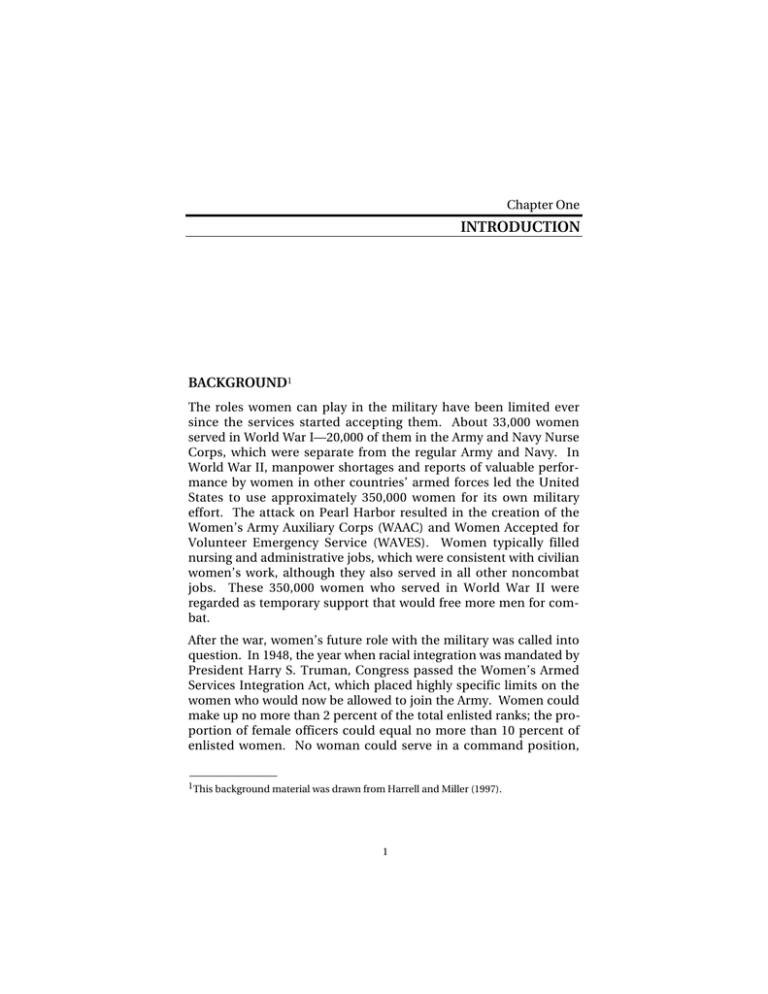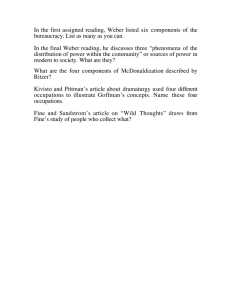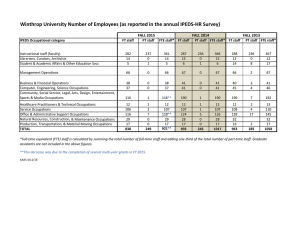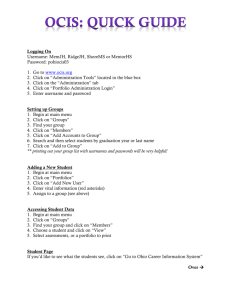INTRODUCTION BACKGROUND
advertisement

Chapter One INTRODUCTION BACKGROUND1 The roles women can play in the military have been limited ever since the services started accepting them. About 33,000 women served in World War I—20,000 of them in the Army and Navy Nurse Corps, which were separate from the regular Army and Navy. In World War II, manpower shortages and reports of valuable performance by women in other countries’ armed forces led the United States to use approximately 350,000 women for its own military effort. The attack on Pearl Harbor resulted in the creation of the Women’s Army Auxiliary Corps (WAAC) and Women Accepted for Volunteer Emergency Service (WAVES). Women typically filled nursing and administrative jobs, which were consistent with civilian women’s work, although they also served in all other noncombat jobs. These 350,000 women who served in World War II were regarded as temporary support that would free more men for combat. After the war, women’s future role with the military was called into question. In 1948, the year when racial integration was mandated by President Harry S. Truman, Congress passed the Women’s Armed Services Integration Act, which placed highly specific limits on the women who would now be allowed to join the Army. Women could make up no more than 2 percent of the total enlisted ranks; the proportion of female officers could equal no more than 10 percent of enlisted women. No woman could serve in a command position, ______________ 1 This background material was drawn from Harrell and Miller (1997). 1 2 The Status of Gender Integration in the Military attain the rank of general, or hold permanent rank above lieutenant colonel. This act specifically prohibited women from being assigned to aircraft or ships engaged in combat missions. Because the Navy and the Air Force have the most ships and aircraft, this act applied most directly to them. However, the Secretary of the Army developed policies to exclude women from direct combat, based upon the implied congressional intent of the Navy and Air Force statutes.2 The doors for women have been pried open slowly over the past four decades. In 1967, the 2-percent cap on enlisted women and some promotion restrictions were lifted; in 1972, the Reserve Officer Training Corps (ROTC) was opened to women; in 1976, the first women entered the service academies; in 1978, Navy women were assigned to noncombatant ships and the Women’s Army Corps was dissolved; in 1989, two women commanded units in Panama; in 1990, the first female commanded a Navy ship; and in 1991, in the Persian Gulf War, large numbers of women moved forward with their units into combat zones, which they were officially forbidden to enter. In 1988, a Department of Defense (DoD) Task Force on Women in the Military created the “risk rule” to bar women from areas on the battlefield where the “risk of exposure to direct combat, hostile fire, or capture is equal to or greater than that experienced by associated combat units in the same theater of operations.” This rule proved very problematic and difficult to interpret. The years 1992 through 1994 saw considerable legislative and policy changes regarding the roles of women in the military. The National Defense Authorization Acts for FYs 1992 and 1993 repealed the combat exclusion law that had prohibited women from being permanently assigned to combat aircraft. In April 1993, Les Aspin, then Secretary of Defense, sent a memorandum to the services that stated Two years ago, Congress repealed the law that prohibited women from being assigned to combat aircraft. It is now time to implement that mandate and address the remaining restrictions on the assignment of women. (Aspin, 1993.) This memorandum directed the services to give women the opportunity to compete for assignment to combat aircraft and to open as ______________ 2 For a detailed history of women in the military, see Holm (1982). Introduction 3 many Navy ships to women as possible under the legal restrictions that still prevented them from being assigned to ships engaged in combat missions. The memorandum also directed the Army and the Marine Corps to study further opportunities for women but did not prescribe additional gender integration in these two services. Instead, it reaffirmed the exclusion of women from units below the brigade level whose primary mission entailed direct combat on the ground. Two critical changes in law and policy pertaining to the assignment of service women were implemented in FY 1994. First, the National Defense Authorization Act for FY 1994 repealed the legal restrictions that had prohibited women from being assigned to combatant vessels. This act also established important guidelines for the integration of women into previously closed occupations when it also required the Secretary of Defense to • • • Ensure that qualification for and continuance in occupational career fields is evaluated on the basis of a common, relevant performance standard and not on the basis of gender; Refrain from the use of gender quotas, goals, or ceilings, except as specifically authorized by Congress; and Refrain from changing occupational standards simply to increase or decrease the number of women in an occupational career field.3 Second, the Secretary of Defense rescinded the risk rule in January 1994 (Aspin, 1994). Instead of closing noncombatant positions or units based upon the risk to personnel in those units, this memorandum directed that women be assigned to all units except those “below the brigade level whose primary mission is to engage in direct combat on the ground.” Direct ground combat was defined as engaging an enemy on the ground with individual or crew served weapons, while being exposed to hostile fire and to a high probability of direct physical contact with the hostile force’s personnel. Direct ground combat takes place well forward on the battlefield ______________ 3 Quoted from U.S. House of Representatives, undated. 4 The Status of Gender Integration in the Military while locating and closing with the enemy to defeat them by fire, maneuver, or shock effect. (Aspin, 1994.) The memorandum also directed that this guidance would be used only to expand opportunities to women and not to close units or positions that had previously been open to them. Two kinds of opportunities resulted from the1992–1994 legislative and policy changes. First, new occupations, or skills, opened to women. Second, units that had previously been closed to women because of the risk rules now opened to women. Given these changes, the House Report for the National Defense Authorization Act for Fiscal Year 1997 directed the Secretary of Defense to obtain an independent study by an FFRDC [federally funded research and development center] evaluating the performance of each military service in integrating women into military occupations previously closed. As part of this study, the FFRDC shall evaluate the effect on defense readiness and morale of integrating women in newly opened occupations and positions as well as factors affecting the pace at which military services are integrating women. The Office of the Secretary of Defense asked RAND to undertake this study (see Harrell and Miller, 1997). In addition to addressing issues of readiness, cohesion, and morale related to gender integration, this prior RAND study confirmed that, in response to the policy and legislative changes, the services had opened more occupations and organizations to women. Table 1.1 shows the change in the number of positions, or billets, opened to women as a result of these changes in the occupations and units open to women. Clearly, progress had occurred in all services. However, the study determined that the numbers of women in some newly opened occupations and positions were still disproportionately low. There were several valid reasons for such underrepresentation, such as the training pipelines that feed the newly opened Air Force pilot and navigator positions. Some newly opened occupations lacked any female volunteers (although it is unclear the extent to which recruiters were encouraging young women to enter nontraditional Introduction 5 Table 1.1 Positions Opened to Women Before and After Legislative and Policy Changes Positions Open (%) Service Before April 1993 After Law, Policy Changes Army Navy Air Force Marine Corps DoD Total 61.0 61.0 97.0 33.0 67.4 67.2 94.0 99.7 62.0 80.2 NOTE: While 94 percent of all Navy positions are available to women, only approximately 13 percent of all shipboard bunks will be female berthing at the end of the current embarkation plan. Thus, the percentage of Navy positions that could be simultaneously filled with women is less than 94 percent. occupations), and many young women did not score well enough on the prerequisite tests to be eligible for the newly opened technical occupations. In some cases, the occupation or skill was open to women, but not all the positions coded with that occupation were open to women because, within that occupation, the women could only be assigned at certain organizational levels, e.g., brigade or higher. While this policy is valid within the guidelines established, the effects of these limitations on both men and women in the career field are uncertain. The study also asserted that invalid limitations also exist and that the limits operate in complex ways. Some positions that are technically open to women may actually be closed because the position is coded to be filled by a skill closed to women, e.g., drill sergeant positions coded with an infantry Military Occupational Specialty (MOS). While some such positions may be appropriately coded, there is no method, other than to check each position individually, to determine whether the MOS coding is valid. Finally, the research found some informal limitations, such as the commander who will not have a driver or an aide of the opposite sex due to the concern of rumors or potential charges of sexual harassment. In other cases, a commander had a woman assigned to an untraditional position, but she actually performed duty in another. 6 The Status of Gender Integration in the Military Following the publication of the 1997 RAND study, a General Accounting Office (GAO) report recommended that the Secretary of Defense direct the services to assess (1) whether requirements for skills or specialties that are presently closed to women are being used inappropriately as prerequisites for positions that are otherwise open to women and (2) whether men or women are receiving an equal opportunity to work within the area of their military specialty (GAO, 1998). The department concurred with this recommendation and agreed to assess the issues. An initial assessment that the Office of the Secretary of Defense and the services conducted concluded that, to obtain a thorough and fair assessment, an outside study should be conducted. A second GAO report addressed the occupational distribution of military women (GAO, 1999). Among other things, GAO found that, although military women continue to work primarily in health care, administration, personnel, and supply occupations, they are beginning to enter more nontraditional fields. However, the report pointed to two institutional barriers to gender integration in the military. First, because some units are closed to women, the number of women who can enter career fields that occur in closed units is limited, even though that occupation is open to women. Second, women tend not to score well on certain portions of the Armed Services Vocational Aptitude Battery (ASVAB) test because they measure prior knowledge in, rather than aptitude for, certain subjects, such as machine shop and electronics repair. SCOPE AND METHODOLOGY OF THIS RESEARCH EFFORT It was in the context of these GAO reports that the Office of Officer and Enlisted Personnel Management, organized under the Assistant Secretary of Defense (Force Management Policy), sponsored this effort to address the gender integration of positions newly opened to women and the paths that lead to these positions. This analysis is intended to address two of the issues highlighted in the GAO reports. First, we examine whether women and men are receiving equal opportunities to work in selected occupations. Second, we consider whether the number of women who can enter the selected occupations is limited, despite the occupation being open to women. To address these two issues, we set two tasks for ourselves. The first was a broad statistical analysis to determine how many women are Introduction 7 assigned to the positions that are open to them. It emphasized the occupations that opened as a result of the legislative and policy changes of the early 1990s. This analysis updated our data about how women are distributed among the newly opened occupations. It also identified the occupations that have low female representation, compared to the representation in the appropriate military service. This analysis took into account the time that has elapsed since integration began; this is an important consideration in any assessment of diversity in a closed system because it will take time for women to progress through these careers. Thus, this statistical analysis provides a benchmark for future comparisons. This first task provides statistical support for a consideration of equal opportunity, or whether women have the same options available to them regarding entry into and success in military careers within the military. A lack of such equal opportunities for women indicates the presence of barriers. Some barriers, such as those that limit the numbers of women in seagoing occupations due to berthing considerations on ships, are likely legitimate. Other barriers, which do not have a credible justification, are not legitimate. Because an assessment of the existence and legitimacy of any barriers requires a qualitative approach, the second task of this research builds on the first. It takes the quantitative output and focuses on selected career fields to determine whether the level of representation most likely results from time elapsed, systemic barriers, or individual choice. INTENT AND ORGANIZATION OF THIS REPORT The text below describes the methodology and data sources we used in this study. Chapter Two summarizes our data analysis across the services, including the number of occupations and positions closed to women, as well as the level of gender representation in previously and newly opened occupations and units. Chapter Three provides more-detailed analysis for selected occupations. Chapter Four presents observations and conclusions. A companion volume (Beckett and Chien, 2002) provides detailed information on the distribution of women across occupations and units available in the data. 8 The Status of Gender Integration in the Military DATA AND METHODOLOGY Phase One To examine the representation of women across occupations and units in each of the services, we use data from the Defense Manpower Data Center’s (DMDC’s) March 1998 Personnel Tempo (Perstempo) file, the most recent data available at the start of this analysis. The Perstempo file contains data from the last month of every quarter from December 1987 to December 1992 and monthly data from January 1993 onward. It provides information on the MOS, unit, and grade and includes demographic characteristics, such as gender and date of birth, for all enlisted personnel and officers in the services (Army, Navy, Marine Corps, and Air Force). The source of this file is the DMDC Active Duty Master Files. The data file is structured such that each observation corresponds to an individual, who is then followed over time so that we can observe the individual throughout his or her time in the service. MOS labels for the Army and Air Force come from the DoD Occupational Conversion Index, which is part of the Occupational Database DMDC maintains. This index includes the DoD occupational grouping, service, MOS, and service occupational title. A Marine Corps representative provided the labels for that service’s occupations. A Navy representative confirmed the information in our previous report and, in some cases, provided updated information about newly opened ratings, Navy Enlisted Classifications (NECs), and designators (the Navy equivalent of enlisted and officer MOS, respectively). In some instances, open occupations are unit specific. For the present report, we restrict analyses to occupations that are not unit specific. The Unit Identification Code (UIC) is a six-character alphanumeric code that uniquely identifies each Active, Reserve, and National Guard unit of the Armed Forces. A master file that DMDC maintains provided labels and addresses for the UICs for each service. Navy representatives also provided us with information on the percentage of female and total slots on previously opened and newly opened ships, total slots on ships opened to women but not yet reconfigured to accommodate them, and total positions on ships still closed to women. Introduction 9 The services provided information on the status of individual occupations and units. When possible, service representatives confirmed that the status of individual occupations listed in the earlier RAND report (Harrell and Miller, 1997) is still current. Because the prior RAND report did not include information on the status of units at the level of detail we used in the current effort, we relied on service representatives to gather this information. In one case, the decentralized nature of the services’ information system made this prohibitively burdensome and time consuming: We were not able to obtain a list of previously closed units from the Army. In such instances as these, we classified units according to the information we did receive. For the Army, we were unable to distinguish between newly open and previously open units. Navy representatives confirmed the status of ratings, designators, NECs, and ship types presented in the previous publication. Unfortunately, the tight integration of occupations and units made it difficult for Navy representatives to provide information about the status of spaces at the UIC level (just at the level of ship types). In addition to not being able to examine the representation of women by UIC, we were also unable to distinguish open and closed occupations that depend on ship or unit type. For example, we classified all support personnel assigned to some naval special warfare units as being in open positions (unless the particular NEC or rating is always closed regardless of group or ship type) because we could not distinguish naval special warfare units from other types of units. The service representatives confirmed the statuses of MOSs and UICs presented in previous publications and provided us with current information on the statuses of occupations and units. Our methodological approach was as follows: 1. We calculated a subgroup mean (or percentage female) and standard error for each MOS and unit subgroup (by service and by enlisted or officer status). 2. Next, we calculated an adjusted overall mean that subtracted from the total sample the people in the particular MOS or unit being compared to the overall mean. If we allowed these people to be double counted in the subgroup and overall mean, the resulting standard errors would be too large. 10 The Status of Gender Integration in the Military 3. We also corrected for the subgroup standard errors by taking the square root of the sum of the squares of the overall standard error and subgroup standard error. The uncorrected standard errors are smaller than the corrected standard errors and hence provided a more liberal test of the significance of differences between overall and subgroup means. 4. We constructed the 95-percent confidence interval for each adjusted overall mean (corresponding to a particular MOS or unit) by multiplying the corrected subgroup standard error by ±1.96. 5. We evaluated whether each subgroup mean fell within the corresponding confidence interval for the adjusted overall mean. If the subgroup was below the 95-percent confidence interval, we concluded that women are underrepresented relative to their overall representation. If the MOS or UIC percentage was above the 95percent confidence interval, we concluded that women are overrepresented relative to their overall representation in that service. While it is analytically useful to identify occupations that have markedly fewer (or more) women than the service overall, we are not asserting that each occupation should have the same representation as its service. Given the importance of time in the closed systems of military careers, we assert that this statistical “underrepresentation” or “overrepresentation” should be considered only as a benchmarking data point for comparison with future studies. Integration targets are discussed in more detail in the ensuing chapters. With the exception of the Army, we classify warrant officers with all other officers. The Navy and Marines have too few warrant officers (and the Air Force has none) to merit a separate category for the purposes of examining representation of women across occupations and units. Phase Two The second phase of this effort focuses on selected occupations determined during the course of Phase 1. These occupations were selected to include nontraditional officer and enlisted positions, to represent all four services, to include occupations with both high and low gender representation and also to include different kinds of occupational areas. Introduction 11 In the course of this research, the third quarter 1999 Perstempo file was released, and we used it to update the counts for the selected occupations. When describing and summarizing issues for each of the selected occupations, we often used service-provided data, which are identified as such in this report.





